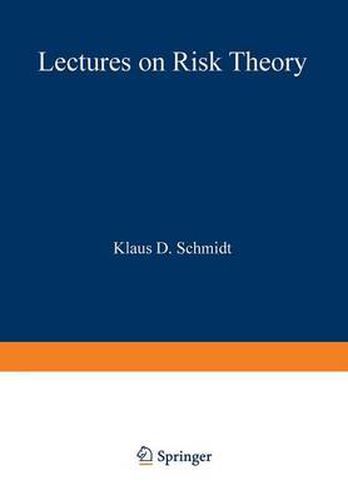Readings Newsletter
Become a Readings Member to make your shopping experience even easier.
Sign in or sign up for free!
You’re not far away from qualifying for FREE standard shipping within Australia
You’ve qualified for FREE standard shipping within Australia
The cart is loading…






This title is printed to order. This book may have been self-published. If so, we cannot guarantee the quality of the content. In the main most books will have gone through the editing process however some may not. We therefore suggest that you be aware of this before ordering this book. If in doubt check either the author or publisher’s details as we are unable to accept any returns unless they are faulty. Please contact us if you have any questions.
Twenty-five years ago, Hans Blihlmann published his famous monograph Mathe- matical Methods in Risk Theory in the series Grundlehren der Mathematischen Wis8enschaften and thus established nonlife actuarial mathematics as a recognized subject of probability theory and statistics with a glance towards economics. This book was my guide to the subject when I gave my first course on nonlife actuarial mathematics in Summer 1988, but at the same time I tried to incorporate into my lectures parts of the rapidly growing literature in this area which to a large extent was inspired by Blihlmann’s book. The present book is entirely devoted to a single topic of risk theory: Its subject is the development in time of a fixed portfolio of risks. The book thus concentrates on the claim number process and its relatives, the claim arrival process, the aggregate claims process, the risk process, and the reserve process. Particular emphasis is laid on characterizations of various classes of claim number processes, which provide alternative criteria for model selection, and on their relation to the trinity of the binomial, Poisson, and negativebinomial distributions. Special attention is also paid to the mixed Poisson process, which is a useful model in many applications, to the problems of thinning, decomposition, and superposition of risk processe8, which are important with regard to reinsurance, and to the role of martingales, which occur in a natural way in canonical situations.
$9.00 standard shipping within Australia
FREE standard shipping within Australia for orders over $100.00
Express & International shipping calculated at checkout
Stock availability can be subject to change without notice. We recommend calling the shop or contacting our online team to check availability of low stock items. Please see our Shopping Online page for more details.
This title is printed to order. This book may have been self-published. If so, we cannot guarantee the quality of the content. In the main most books will have gone through the editing process however some may not. We therefore suggest that you be aware of this before ordering this book. If in doubt check either the author or publisher’s details as we are unable to accept any returns unless they are faulty. Please contact us if you have any questions.
Twenty-five years ago, Hans Blihlmann published his famous monograph Mathe- matical Methods in Risk Theory in the series Grundlehren der Mathematischen Wis8enschaften and thus established nonlife actuarial mathematics as a recognized subject of probability theory and statistics with a glance towards economics. This book was my guide to the subject when I gave my first course on nonlife actuarial mathematics in Summer 1988, but at the same time I tried to incorporate into my lectures parts of the rapidly growing literature in this area which to a large extent was inspired by Blihlmann’s book. The present book is entirely devoted to a single topic of risk theory: Its subject is the development in time of a fixed portfolio of risks. The book thus concentrates on the claim number process and its relatives, the claim arrival process, the aggregate claims process, the risk process, and the reserve process. Particular emphasis is laid on characterizations of various classes of claim number processes, which provide alternative criteria for model selection, and on their relation to the trinity of the binomial, Poisson, and negativebinomial distributions. Special attention is also paid to the mixed Poisson process, which is a useful model in many applications, to the problems of thinning, decomposition, and superposition of risk processe8, which are important with regard to reinsurance, and to the role of martingales, which occur in a natural way in canonical situations.